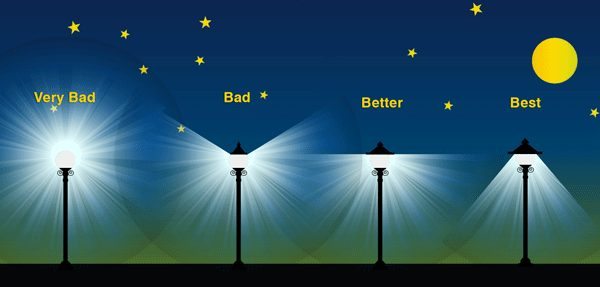The night sky which was once visible to the bare eyes, clear with millions of stars can be hardly seen today due to the Light Pollution. Light pollution, also known as photo pollution, has been present in the environment over the last 50 years. This phenomenon is caused due to the excessive use of artificial outdoor lighting by human beings, especially in large cities and now sprawling into suburban and rural areas. Unknowingly we all are contributing towards the emission of light pollution through the use of regular conventional lights which releases carbon footprints to the ecosystem. This type of pollution is common mostly in Asia, North America and Europe. The most polluted country in the world is found to be Hong Kong and China.
According to the Ecology and Society Journal in 2010, the use of artificial lighting increases by 20% each year hence, this problem needs to be addressed urgently in order to protect humans, animals and the environment from its harmful side effects.
Some of the consequences of light pollution are :
- Excessive use of energy
- It affects the health of people residing in cities
- Disturbs in sleeping, eating and migration cycle of birds
- It hampers the study of astronomy and meteorology in the night sky as it becomes difficult to observe

To reduce this type of pollution we should improve the outdoor lighting practices orelse rather than serving the purpose of providing visibility and safety at night, it will start hampering the lives of others. Here are few tips on how to control it.
- Try to use CFL (compact fluorescent lamps) and LED bulbs that produce warm white light. There are some LED lights available in the market which causes eyestrain and impairs night vision adding towards light pollution.
- Always choose a shielded light fixture that prevents light from being emitted directly to the sky and minimizes the light pollution.
- Use motion sensor lights on outdoor fixtures so that they can switch off/on whenever needed. Test the lights before purchasing and adjust the motion detectors sensitivity to prevent unnecessary turning on and off.
- Always go for ISO 9001 Certified which can minimize glare, light spill, and sky glow.
- Simple steps like turning off unwanted outdoor lights when everyone is at home or going to sleep can prevent from wasting energy consumption. Not only at home even when at work or community take the step towards saving light and energy for a better future.

To understand more about light pollution there are 4 types of the same. By identifying each form of light we can prevent multiple types of pollution. They are-
- One of the results of light pollution is Sky glow. This is the partial or full obstruction of natural night sky which can be seen mostly in metropolitan cities. The color of the night sky slowly brightens from black, orange to red due to the use of artificial light in an extended way. It disturbs the wildlife, environment, humans, energy resources and astronomers.
- Light Trespass or light spill are subjected to disturbing lights from foreign sources like headlights from a highway. This often leads to interruption of daily activities and deprive from sleep.
- Glare, this another type wherein human eyes are affected due to the bright light as they are not accustomed to it and it leads to visual discomfort and temporary or permanent damage of eyesight. It can be very dangerous while driving as it can blind the field of vision ahead.
- When there is an excessive grouping of bright lights that cause confusion and distract from oncoming or surrounding objects this pollution is called Light Cutter. Unshielded street lights and brightly lit advertisements or signs creates a hazardous environment for drivers and pilots because it competes with traffic and navigation signals.
Most percentage of light pollution comes from outdoor lighting when they are poorly designed and left unshielded. More than 50% of the unshielded lights contribute towards light skyward or sideways leading to pollution. In such cases only 40% of the light has been found to be actually illuminating the ground and rest is wasted.

